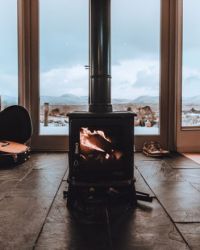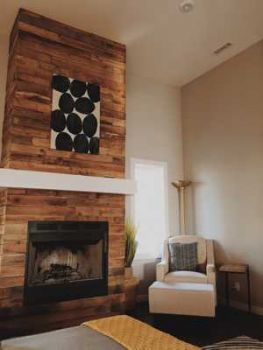Archive for May 2020
 Wood stoves are becoming increasingly popular in the USA, with more than 10 million homes using them regularly, according to the U.S. Energy Information Agency. Anyone investing in a new wood stove needs to take many factors into consideration before parting with their money. This is particularly true for seniors who need to make sure that the stove they choose is not only easy to use, but safe and practical as well. Following a few simple tips will make it a lot easier to find the most senior-suitable wood stove on the market.
Wood stoves are becoming increasingly popular in the USA, with more than 10 million homes using them regularly, according to the U.S. Energy Information Agency. Anyone investing in a new wood stove needs to take many factors into consideration before parting with their money. This is particularly true for seniors who need to make sure that the stove they choose is not only easy to use, but safe and practical as well. Following a few simple tips will make it a lot easier to find the most senior-suitable wood stove on the market.
Size does matter
One of the most important considerations when choosing a wood stove is its size. When choosing a wood stove for a senior it is important to determine what exactly it will be used for. Will its primary purpose be to heat the home, prepare food on, or to create ambiance? If the senior is living in a relatively small home, there is no need for an over-sized oven. In fact, installing a wood stove that is too big will waste fuel, pollute the air, and even result in a severe fire hazard thanks to a creosote build-up. It is always best to pick the smallest stove that can heat the required space efficiently as this will allow you to burn a clean, hot fire without overheating your living area and posing a threat to your health and well-being.
There is no need to break the bank
While there are undoubtedly woodstoves on the market that carry a very hefty price tag, there are also plenty of more affordable and equally as effective stoves available. Many seniors are already faced with several budgeting challenges and investing in an overpriced stove will just exacerbate the concern. Draw up a budget and stick to it. Do not be cajoled into spending extra money on fitting and features you do not need. A top-of-the-range ultra-modern wood stove may look nice but at the end of the day it will, more than likely, not warm your room or boil your water any better than a much more affordable model.
Don’t disregard aesthetics completely
Although a wood stove’s overall performance is of greater importance than its design, aesthetics should not be disregarded completely as they can be linked to distinct benefits for senior owners. Stoves typically either stand on legs or a pedestal. Some stoves even have adjustable legs which are ideal for wheelchair users. Wood stoves generally boast a single door, a double door, or a side door. A glass door allows you to keep an eye on your wood levels inside without causing a disruption to the combustion process. Stoves with flat tops are easier to cook on and pose less of a burn hazard than those with removable burners.
There are many benefits to owning a wood stove. As long as proper research is conducted before making a purchase, a senior can safely enjoy the wonderful warmth emitted by a cozy wood-burning stove.
1.9 percent of US households still use wood for their heating needs as opposed to electricity or utility gas, according to a report by the US Census Bureau. Many people still rely on wood not only since it's usually cheaper than the other alternatives but also since it is better for the environment. While woodburning stoves are mostly installed in the living room or kitchen, you can find them anywhere in a home including in a bedroom, home office, or even your mancave. If you are lucky enough to have a mancave, adding a woodburning stove is a surefire way to make it so much better than it already is, especially if you live in an area that gets cold from time to time. However, being an addition that could potentially be dangerous, you must be careful to ensure that you install it correctly.
Choosing an ideal spot for your woodstove
You must make the decision of where you're going to be putting your stove in your mancave long before going out to buy one. Since a wood stove is a space heater, you want to have it installed in a central position where it can heat every corner of your mancave. To maximize its efficiency, pick a spot with good insulation so that the heat from the woodstove is not lost through windows or walls. You also want to install it in a spot where it won't cause your TV, gaming console, or other electrical appliances in your mancave to overheat. Keep in mind that your woodstove will require a chimney, which ideally should be vertical and with as few bends as possible.
Make it multifunctional
One of the things that people love most about mancaves is that they give you a safe spot where you can hide away from the rest of the world and be alone for as long as you want. To further cement this feeling in your mancave, you can choose a woodstove that allows you to cook on it. There are various wood stove options that are specifically designed to allow people to cook while still performing their primary function of heating, but any with a flat surface on top that's large enough to hold a cooking pot will do. This addition can transform your mancave from a place you hang out in from time to time to a prepper's dream space where you can live, eat, have fun, and stay warm for as long as you need to, even when there are power outages.
Choosing a wood stove
After identifying an ideal spot in your mancave to install your woodstove, the next step is to choose one. Modern wood stoves come in various sizes, designs, and finishes and not all of them will be a good fit for your mancave. The first thing to consider is the size of your woodstove which will depend on how much space you have in your mancave and your heating needs. You want a stove that is big enough to meet your heating needs but not too big that it makes your mancave uncomfortably warm or takes up too much room. Another thing to consider is the stove's clearance rating, which is the minimum distance you should maintain between the stove and nearby walls, furniture, and appliances. You must also consider the design of the woodstove and how it fits in with the overall design or theme of your mancave. Whatever you end up choosing, make sure that it is certified by the Environmental Protection Agency.
A woodstove could be the thing that is missing in your mancave to take it to the next level. Not only will it make your mancave warm and cozy but it can also add to the aesthetic appeal and make it feel more homely. But, to be on the safe side, make sure your installation is done by certified professionals who'll follow safety guidelines to the letter.
Pest such as cockroaches, rodents, and ants can make their way into your home from many sources, and it is important to keep your home sealed against them to avoid health consequences and discomfort. Pest types vary according to state and some years are worse than others - for instance, 2018 year saw flies, ants, and mosquitoes plague people in 41 states, with around 34% of people seeking professional solutions. Proper installation of fireplaces will help reduce the risk of pests entering your home in warm and cold seasons alike but you can take additional steps to keep your home 100% pest-free.
Installing a Fireplace Door
A fireplace door that is resistant to heat can be completely shut when your fire isn’t burning. This is key during winter, since small animals and rodents can seek warmth in homes, making an entryway though your chimney. Installing a door will make your home considerably less interesting, and you can keep rodents completely out by shutting the chimney once the embers are no longer aflame.
Organize Your Firewood
If you have a large storage space for your firewood, ensure that the logs are organized according to the date of acquisition. Make sure to burn the oldest logs first, since insects have a greater likelihood of producing a sizable colony in old wood. Be particularly strict with log use if you live with people with allergies and respiratory conditions. Toxic pests can trigger asthma and other allergies. In fact, around one third of people with other allergies are also allergic to cockroaches. Symptoms of exposure include everything from chest pain to wheezing. To keep these issues at bay, ensure that logs are neatly and clearly stored so that everyone in the family knows where they should be taking wood from when they wish to start a fire.
Buy Recently Cut Wood
Unless you cut wood yourself, buy wood cut in the recent months to ensure it is fresh and pest-free. If supply of fresh wood is low, consider contacting local logging companies, tree services, and professionals in the reclaimed lumber industry. Check wood before you bring it indoors, ensuring that beetles, carpenter ants, and termites are absent. Bring wood in at the moment you will be burning it, to avoid insects infesting other items of furniture in your home.
Store Wood Optimally
You should store wood far from the fireplace; ideally, all wood should be stored outdoors. Aim to store wood off the ground, to reduce the amount of moisture buildup in the wood. To achieve this goal, consider storing wood atop a makeshift table made of bricks or concrete blocks. To ensure bringing logs to and fro is easy, invest in a log trolley. These are available for $30 or less and can be considered a small investment in your back health. Free reclaimed wood is sometimes available from excavating companies, owners of old barns, remodelling contractors and the like.
Insects and rodents can make their way into your fireplace either through old logs or through the chimney. Fireplace doors and chimney flues will keep rodents out, while using new wood and storing logs outside will ensure insects do not infest your home. Pests can have a big effect on your family’s health and this is especially true for those with asthma and other allergies. The good news is that being vigilant and organized will reduce the chances of a home infestation to zero.

